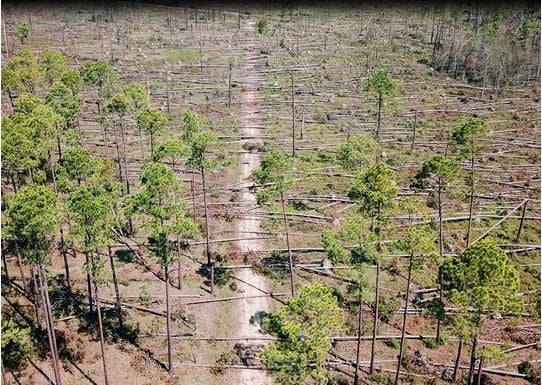2 min read
Louisiana Timber Losses from Hurricane Laura Surpass $1.1 Billion
Mike Powell : October 1, 2020

Per recent data and accompanying news from the LSU AgCenter, Hurricane Laura will go down in history as one of the most destructive and expensive storms to ever hit the state of Louisiana.
Laura struck the Louisiana coastline in the early morning hours on August 27 as a category 4 storm with sustained winds of 150 mph. The last time the region experienced a weather event with wind speeds this strong was when the Last Island Hurricane struck in 1856. Prior to Laura, that storm was the strongest hurricane to make landfall in Louisiana history, and it is tied as the fifth-strongest hurricane on record to make landfall in the continental US.
It goes without saying that 150 mph winds accompanied by a 9-foot storm surge caused widespread devastation to the Louisiana landscape. Reporting from the AgCenter put early estimates at over $1.5 billion in damage; $525.4 million in damage to Louisiana’s agriculture industry, and $1.1 billion in damage to Louisiana’s timber industry.

Photo by U.S. Department of Agriculture Forest Service
Read more of our content related to severe weather events and their impacts on southern timberland:
-
How Have Recent Gulf Coast Hurricanes Affected Stumpage Price?
-
Timberland Management in the Wake of a Natural Disaster
-
Will Hurricane Harvey Dampen the Construction Boom in Texas?
-
Carolinas Stumpage Market: Identifying Imbalances After Hurricane Florence
-
Precipitation Event Impacts: Mill Inventories & Delivered Price
LSU AgCenter economist Kurt Guidry and forestry specialist Michael Blazier estimate that Laura destroyed 757,538 acres of timber from the southwest to northeast regions of the state. The damage estimate includes national forests as well as privately owned land. In comparison, agricultural losses—including forestry, crops and fisheries—from Hurricanes Katrina and Rita totaled $1.5 billion in 2005.
“Based on the amount of infrastructure damage that occurred and the losses associated with timber, the total economic impact to the food and fiber sector from Hurricane Laura will be as large as or larger than any storm that I have developed estimates for since my time with the AgCenter,” said Guidry.
Blazier added that Laura will likely go down as the most devastating storm to the state’s timber resources—even more destructive than Katrina and Rita combined. “It’s demoralizing. I checked and checked and rechecked the figures, and if anything, it’s conservative,” he said.
Using data from aerial surveys by the Louisiana Department of Agriculture and Forestry, the AgCenter produced the following estimates by parish:
- Vernon Parish: $360 million in timber losses on 160,416 acres
- Rapides, Beauregard, Grant and Allen parishes: $100 million+ each in timber losses
- Calcasieu Parish: $76.7 million in timber losses on 188,292 acres
Unlike Hurricanes Katrina and Rita, which brought excessive flooding due to storm surge and rainfall, Laura’s destruction was largely driven by powerful winds. The AgCenter notes that “The heaviest damage tracked the path of the storm’s eye as it went almost all the way to Arkansas as a hurricane. Anecdotal evidence suggests the worst damage occurred in forests that had been thinned recently. ‘There was just more wind that could come through those stands,’ Blazier said.”
For more information about timberland management and natural disasters: Surveying Timberland Damage in the Wake of Major Hurricanes
The AgCenter report also determined that only 10 percent of the downed pine trees can be salvaged and that none of the damaged hardwood trees are salvageable. Downed timber in Louisiana’s humid environment must be salvaged quickly. “We have a very short window, maybe less than a month,” Blazier added.
Hurricane Laura will have both near- and long-term effects on Louisiana’s wood supply chain. Stumpage markets will react differently based on the extent of the damage, demand for timber resources, etc. At the landscape level, we expect to see near-term stumpage prices reflect the increase in salvaged wood available to the market, which will apply downward price pressure over the next several weeks. However, stumpage prices will then become more volatile and likely trend higher thereafter—once the market works through the usable salvaged timber—and the regional supply chain adapts to new operating conditions that reflect the loss of over $1 billion in timber resources.
We will continue to monitor the situation and provide additional data when it becomes available.





